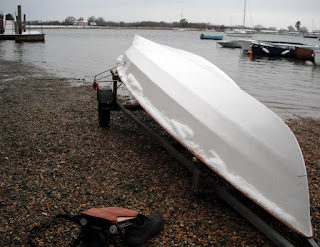This lot of wood is a kit boat for a Woods Bee that Alec Jordan cut for me a loooong time ago, which I have failed to even start to build. It should be a rowing/sailing dinghy by now, looking something like this:
Progress of a sort has been made - one of the sheets of exterior grade ply that the kit came packed in were made into the washing-up bowl shaped boat in the front there. As Simbo, she has won me the title of Biggest Bloke in the Smallest Boat 2010.
So I hereby resolve that the kit will be built in 2011.
Although first I have to transform the other packing sheet into a cordless-drill-powered boat for the Water Craft competition at Beale Park (I will use another of Hannu's brilliant designs, Prism).
 And then there is this, which will occupy a good deal of my time I hope >>>------->
And then there is this, which will occupy a good deal of my time I hope >>>------->And there is another building project looming, training for the Great River Race, and I am hoping to cash in on some invitations to go sailing this year as well.
So perhaps 2012 is a more realistic aim.....
















































